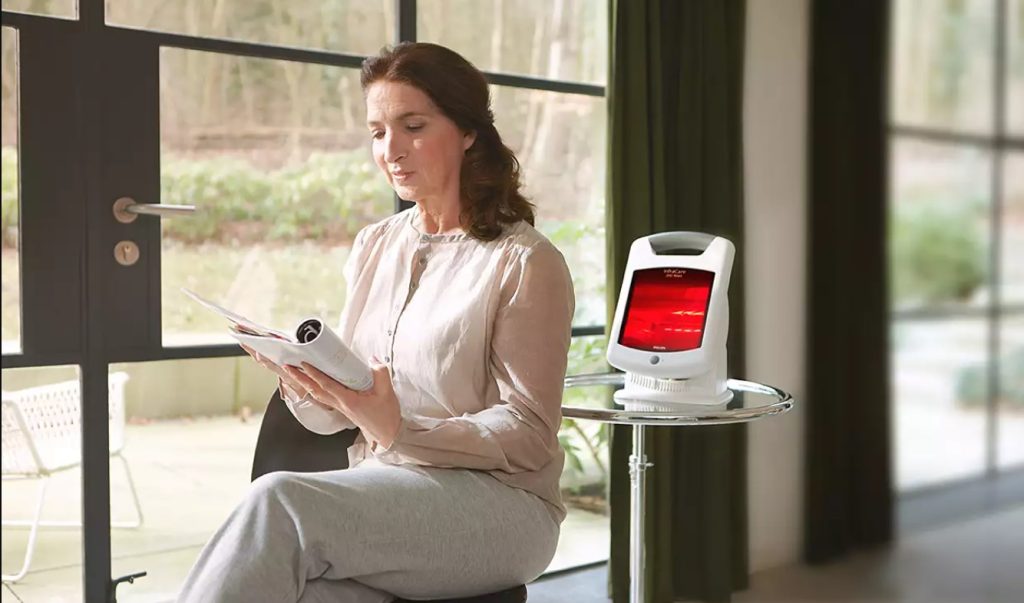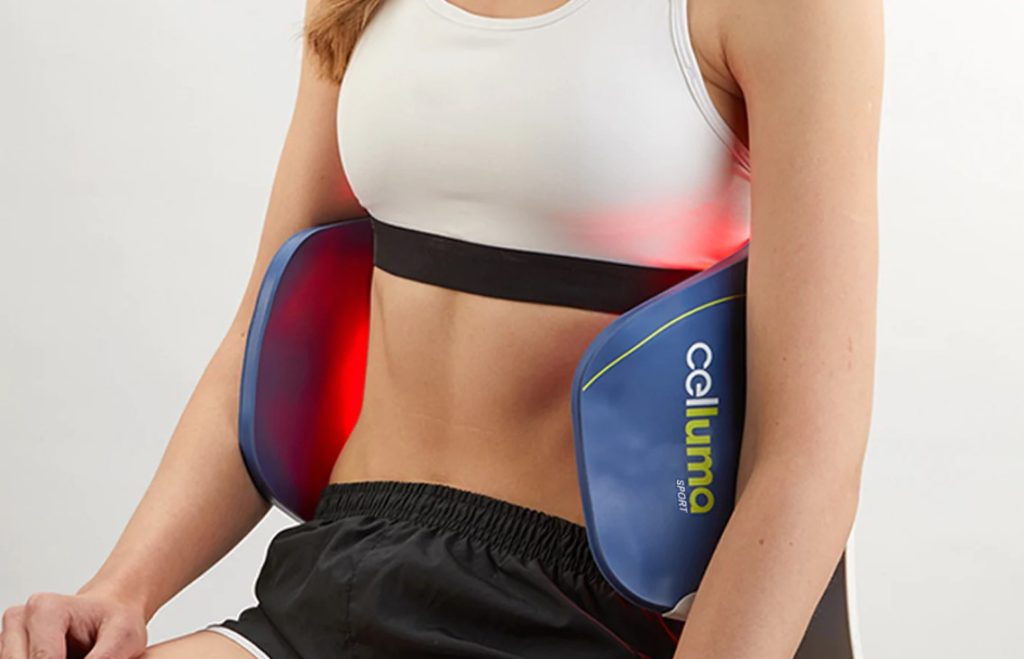Light therapy, particularly infrared light therapy, has been on the rise lately. Professional and amateur athletes use it to ease muscle and joint pain, soreness, as well as lower back pain, and with good reason.
Infrared and red light have proven to possibly be effective in treating inflammation and wound healing. Much scientific research supports the idea that infrared light might offer pain relief benefits that pretty much anyone can apply. But you might be wondering how to use infrared lamp for muscle pain.
If you’re interested in infrared light therapy but don’t know much about it, don’t worry. Here we will look at how infrared therapy works concerning your body and how to effectively use the devices like floor lamps, infrared heaters, etc.
So, if you want to know more, continue reading.

How to Use Infrared Lamp for Muscle Pain
The infrared light emits deep penetrating heat, which might help in increasing blood flow, relaxing muscle spasms, and removing harmful toxins. Most importantly, might be effective in relieving muscle pain. Before using an infrared lamp for muscle pain at home, you should consult a healthcare professional for extra caution.
If you’re using an infrared lamp at home, you should know that you mustn’t sleep during the treatment and keep it away from children and pets. Here is how you can use it to relieve your muscle pain:
- Set the infrared lamp in a calm place.
- Sit next to the lamp comfortably, keeping the lamp head 9-12 inches away from the skin.
- Stay in that position for about 20 minutes.
- Repeat this treatment a maximum of two times per day.
For the first four weeks, you should do five to seven treatments per week. Whereas for the following eight weeks, you should use it thrice a week and after that as needed.
Note: If you notice any side effects, such as increased pain or swelling, discontinue using the infrared lamp and see a doctor. This treatment is not recommended for people with light-sensitive skin because it may cause discoloration.
What Happens in Your Body When You Use Infrared Light Devices?
What exactly happens under your skin when you use an infrared light therapy device? The light that penetrates through multiple layers of skin and reaches deep muscles and nerves brings heat energy to these places.
So, the tissues’ cells absorb the energy and become more active. Blood flow may increase to this area and activate further cellular regrowth and regeneration.
The combination of these activities may reduce inflammation and repair injuries or wounded areas, according to some research.
What Type of Pain Can Infrared Light Therapy Treat?
Infrared light therapy devices can target pretty much any area of the body except the eyes. Infrared light is widely used because of the benefits it may provide to the body.
That said, it might be helpful in treating the following symptoms:
- Neck pain and stiffness
- Shoulder pain
- Upper and lower back pain
- Knee pain or stiffness
- Wrist pain, including carpal tunnel syndrome
- Pain in feet from standing all day
- Ankle aches caused by running
- Intense pains in the hands
- Arthritis
Chronic lower back pain is one of the most common reasons for using infrared light therapy. Many experts estimate that back pain affects around 80% of people at some point in their lives.
Some flexible, wrap-around infrared devices are tailor-made to possibly help people with pains in the lower back and around the waist. Oral care LED devices also employ infrared light to treat inflammation and pains in the gums or teeth.
Research Done on Infrared Light Therapy
In general, infrared and light therapy are new concepts in the healthcare community. Due to this, the research on the effects they might have on the body is still in the early stages.
However, the research that has been done potentially confirms infrared light therapy’s efficiency and the interest in the technology keeps growing.
Back pain research
A medical journal, Pain Research & Management, has published a study considering infrared therapy for chronic lower back pain.
The study followed 40 patients over a period of six years. All of the patients applied wearable devices that emitted infrared light in the range of 800-1,200 nanometers. The patients reported a significant reduction in pain without any negative effects.
The Turkish Journal of Physical Medicine and Rehabilitation published another study that examined the impact infrared light had on spondylitis, inflammatory arthritis of the spine.
Patients that were treated experienced significant improvements in function, activity, and general quality of life.
Nerve pain research
Infrared light’s ability to stimulate nerves and help wounds to heal has been confirmed in a recent article done by the journal Photochemistry and Photobiology.
Other uses
There are many current studies into infrared light therapy, with the most popular ones potentially improving blood circulation in people with diabetes.
The medical community is also looking at ways it can be used in neurosurgery. With more and more sophisticated research, red light therapy has a bright future in the medical field.

Infrared Light Therapy Safety Tips
When looking at how to use infrared lamp for muscle pain, it’s important to understand some safety tips. You should follow them in order to avoid causing yourself unnecessary harm.
- Make sure that your eyes are protected, and use safety goggles or other items that can cover the eyes.
- Do not touch the lamp after it’s been on for a while, it gets very hot.
- Make sure you turn off the lamp and unplug it after use
- Don’t keep it close to fabrics or flammable furniture.
- Always keep it at 9-12 inches from your skin, and make sure not to get too close.
Always be sure to read the manufacturer’s instructions and safety tips, and in the case of any adverse effects, contact a medical professional.
Look for FDA-cleared devices
Before buying an infrared light device, choosing a safe and high-quality product is important. To achieve this, only look at FDA-cleared devices. This designation means that the devices are reviewed by the FDA and determined that the manufacturer produces a safe device.
Light therapy devices meant for treating pain, and other medical conditions are even eligible for FDA benefits.
What Exactly Is Infrared Therapy?
Infrared light is one of many new innovative therapies that utilize light. These therapies are at the forefront of a potential new way to help patients with acute and chronic pain. This type of therapy uses certain wavelengths of light that are concentrated on parts of the body with injuries.
Unlike UV light, which could potentially damage skin tissue and cells of the body, infrared light may help cells regenerate faster and allow for injuries to repair themselves. One of the most substantial reasons why infrared light might help with the body’s healing ability is because it may improve circulation and bring oxygen-rich blood to the injured part of the body.
Another unique characteristic of infrared light is its ability to penetrate the skin, which may effectively relieve pain in muscle tissue found deeper under the skin and fat tissue. Plus, the whole process may be non-invasive, natural, and painless.
Infrared light is the heat that is usually felt by the sun. However, when it comes from the sun, this heat is accompanied by UV light that could damage the skin. On the other hand, infrared light therapy has been shown to possibly provide immense benefits, from pain relief to reduced inflammation.
History of infrared light therapy
NASA first used infrared light therapy in a clinical context in the 1990s. Since then, scientists have stated that it may have positive effects on many other types of living tissue.
Infrared waves can penetrate deep into the human body and may help promote cell regeneration and increase blood flow. This prevents cell death that causes tissue damage. Regular infrared therapy treatments may result in less muscle soreness, fewer spasms, and less joint stiffness.
Small infrared light therapy devices that are made for personal use are a more recent innovation. These devices may deliver infrared energy to a particular body area more easily. This allows you to concentrate infrared light directly into surfaces where you might feel nerve pain or muscle stiffness.
Infrared light therapy devices for home use have become very popular, and many people are using them, from professional athletes to individuals with chronic or mild pains. Results might be best achieved through the devices’ regular use.
The Difference Between Infrared Light and Red Light
If you’re considering any type of light therapy, you might feel confused by the many different products that are available on the market.
Currently, red light and infrared light therapies are the most prominent and can often be mixed up. So, it’s important to establish the difference before you get deep into infrared light therapy.
The possible reason why red light therapy is confused with infrared light is that red light falls under the infrared part of the light spectrum. However, there is a huge difference between the two.
Even though they share the same area in the wavelength spectrum of natural light, red light has a much shorter wavelength, between 650 and 750 nanometers. On the other hand, infrared light has a much larger wavelength of over 750 nanometers and is invisible to the human eye.
Due to this difference in wavelength, both have separate clinical applications. Red light works primarily on the skin surface and doesn’t penetrate inside the body much, while infrared light therapy can reach deep into the body and treat muscle and nerve damage. This is why it’s important to understand the difference.
Conclusion
If you’re interested in red light therapy as a way to alleviate muscle pain, this is the way to go. The process has been medically proven to be both safe and effective.
If you’re wondering how to use infrared lamp for muscle pain, it can’t get any simpler. The devices are easy to use, which makes them ideal for home use and means that you can immediately start implementing light therapy in your daily life.
However, safety must come first. So, before using an infrared lamp, you should consult a healthcare professional for a better experience and an exact schedule for the treatment. Not all people have the same condition, and not all of them will have the same results.
Consulting with a professional is the best way to approach this therapy.

Hello! I’m Nicky Rodgers.
Almost a decade ago, I got excited about the idea of employing alternative methods like red light therapy to create a healthier life.
To learn more about it, I did my Certified Light Therapist course from Photonic Therapy Institute and started looking into the intricacies of how light therapy influences several bodily processes. Before I knew it, my interest had become an obsession which resulted in this extensive blog.
Here, I offer countless well-researched articles to help you understand the benefits and uses of light therapy. I hope this information gives you a head start in your wellness journey.
